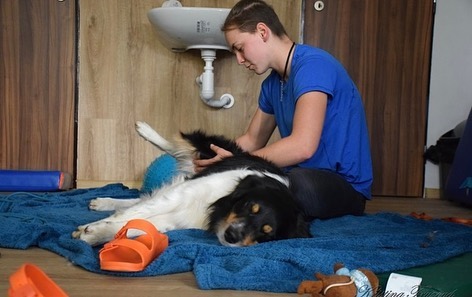Have you ever noticed your dog stretching their back legs? It’s a common behavior that can catch our attention and leave us wondering about its significance. While stretching is a natural behavior in dogs, persistent or excessive stretching may be a signal of underlying issues that warrant further attention. In this blog post, we will delve into the intriguing phenomenon of dogs stretching their back legs and provide valuable insights into the possible causes behind this behavior.
The purpose of this post is to help dog owners better understand why their furry companions engage in this behavior and offer potential solutions to address any underlying concerns. By gaining a deeper understanding of the reasons behind back leg stretching, we can provide the best possible care for our beloved pets.
Stretching is a vital aspect of a dog’s daily routine, as it helps maintain flexibility, promotes blood circulation, and keeps muscles healthy. However, it is crucial to distinguish between normal stretching patterns and behaviors that may indicate underlying issues. Persistent or excessive stretching, difficulty returning to a normal position, or signs of discomfort during stretching may be signs that something requires attention.
Throughout this blog post, we will explore the common causes of back leg stretching in dogs. We will examine potential medical reasons, such as muscle stiffness, joint pain, or musculoskeletal issues, that can lead to this behavior. Additionally, we will explore behavioral causes, including stretching as part of the waking-up routine, preparing for exercise, or seeking attention from their owners. Age, breed, and overall physical condition also play a role in determining the likelihood of back leg stretching.
Recognizing abnormal stretching patterns is an essential aspect of responsible pet ownership. By learning to differentiate between normal and abnormal stretching behaviors, we can identify potential underlying problems early on. Seeking veterinary advice is crucial if back leg stretching appears abnormal or is accompanied by other concerning symptoms. A veterinarian can conduct diagnostic examinations to determine the underlying cause and develop an appropriate treatment plan.

In addition to addressing medical causes, we will also discuss behavioral solutions. Implementing regular exercise routines, providing mental stimulation, and ensuring a comfortable sleeping environment can help address behavioral causes of back leg stretching. We will also highlight the importance of warm-up exercises and cool-down routines before and after physical activities to prevent muscle strain and stiffness.
By understanding the reasons behind a dog’s back leg stretching behavior and exploring potential solutions, we can better care for our furry companions. It is our aim to provide valuable insights and guidance to help dog owners promote overall muscle health and ensure their pets lead lives full of vitality. Together, let’s unravel the mysteries of back leg stretching and create a healthier and happier future for our beloved dogs.
You may like: Can dogs eat Grits?

The Nature of Dog Stretching:
Stretching is a natural behavior in dogs that serves several important purposes. It plays a crucial role in maintaining flexibility, promoting blood circulation, and keeping muscles healthy. Introducing the concept of stretching in dogs allows us to understand its significance in their overall well-being.
Dogs exhibit various typical stretching behaviors that can help establish a baseline for understanding normal stretching patterns. For example, the downward dog pose, where a dog stretches their front legs forward and their hind end upward, is a common stretch that helps lengthen the spine and stretch the leg muscles. The play bow, where a dog lowers their front end while keeping their rear end up, is another typical stretching behavior often seen during playtime or social interactions.
By familiarizing ourselves with these common stretching behaviors, we can better appreciate the normal range of motion and postures that dogs exhibit during stretching.
You may like: Why does my golden retrievers pant so much?
Common Causes of Back Leg Stretching:
Back leg stretching in dogs can have various causes, both medical and behavioral. Highlighting possible medical causes helps us understand the potential underlying issues that can lead to this behavior. Muscle stiffness, joint pain, or musculoskeletal issues, such as arthritis or hip dysplasia, can contribute to dogs stretching their back legs. These conditions may cause discomfort or restricted mobility, leading the dog to stretch in an attempt to alleviate the discomfort or increase range of motion.
Behavioral causes can also contribute to back leg stretching. Dogs may stretch as part of their waking-up routine to shake off sleepiness and prepare their muscles for activity. They may also stretch before or after exercise as a way to warm up or cool down their muscles. Furthermore, dogs may stretch as a way to seek attention or communicate their readiness to interact with their owners.
Age, breed, and overall physical condition can influence the likelihood of back leg stretching. Older dogs may be more prone to muscle stiffness or joint issues, while certain breeds may be predisposed to specific musculoskeletal conditions. The dog’s overall physical condition, including fitness level and any pre-existing health conditions, can also impact their stretching patterns.
Identifying Abnormal Stretching Patterns:
Differentiating between normal and abnormal stretching patterns is crucial for identifying potential underlying problems. Providing guidance on what to observe and look out for helps dog owners recognize signs that may indicate a need for further investigation. Excessive or prolonged stretching, difficulty in returning to a normal position after stretching, or signs of discomfort or pain during stretching can all indicate abnormal stretching patterns that warrant attention.
By paying close attention to our dogs’ stretching behaviors and being aware of any deviations from their usual patterns, we can better assess their overall well-being and potential underlying issues.
Seeking Veterinary Advice:
If a dog’s back leg stretching appears abnormal or is accompanied by other concerning symptoms, consulting a veterinarian is essential. Emphasizing the importance of seeking veterinary advice encourages responsible pet ownership and ensures proper care for our furry companions. A veterinarian can conduct thorough examinations, potentially including diagnostic procedures, to determine the underlying cause of the abnormal stretching behavior.
Early detection and treatment of any underlying medical conditions are crucial for maintaining our dogs’ health and well-being. Veterinary care can help identify and address musculoskeletal issues, muscle stiffness, or other medical conditions that may contribute to back leg stretching. The benefits of early intervention include improved management of discomfort or pain, prevention of further complications, and a higher quality of life for our beloved dogs.
By consulting a veterinarian when necessary, we can gain a better understanding of the potential causes of back leg stretching and provide appropriate care for our dogs’ specific needs.
You may like: How far can a 12 week old puppy walk?
Addressing Behavioral Causes:
Implementing regular exercise routines is essential for maintaining a healthy and active lifestyle for our dogs. Engaging in activities such as daily walks, playtime sessions, and interactive games can help keep their muscles strong and flexible. Regular exercise not only provides physical benefits but also stimulates their minds, helping to alleviate boredom and reduce stress levels.
Proper warm-up exercises and cool-down routines are vital components of any exercise regimen. Just like humans, dogs can benefit from gradual warm-up exercises before physical activities to prevent muscle strain and stiffness. A brisk walk or gentle stretching exercises can prepare their muscles and joints for more intense exercise. Similarly, a cool-down routine after exercise, involving gentle movements and stretching, can help prevent post-workout muscle tightness and discomfort.
Promoting Overall Muscle Health:
Maintaining optimal muscle health is essential for dogs, and promoting muscle strength and flexibility can help reduce back leg stretching behaviors. Regular exercise, such as walks, playtime, and interactive games, plays a vital role in building and maintaining muscle strength. Activities that engage multiple muscle groups, such as fetching or playing tug-of-war, can be particularly beneficial.
Incorporating activities that promote stretching and muscle conditioning into your dog’s routine can contribute to their overall muscle health. Consider introducing them to agility training, which involves navigating obstacle courses, or teaching them swimming, which is a low-impact exercise that works various muscle groups. Canine fitness classes or exercises specifically designed for dogs, such as balance exercises on a stability ball or treadmill workouts, can also aid in muscle conditioning and flexibility.
Stretching exercises designed for dogs can be a valuable addition to their daily routine. Gentle stretches that target their major muscle groups can help improve flexibility and prevent muscle tightness. Consult with a professional, such as a certified dog trainer or a veterinarian, to learn safe and effective stretching exercises for your dog’s specific needs.
By addressing behavioral causes through regular exercise mental stimulation and providing a comfortable sleeping environment we can help reduce back leg stretching in dogs promoting overall muscle health through exercise routines engaging activities and incorporating stretching exercises can further enhance their well being and minimize the likelihood of this behavior.
Remember to tailor the activities to your dog’s age, breed, and physical condition. Always prioritize their safety and well-being, and consult with professionals for guidance and support in promoting their muscle health and overall happiness.
You may like: Do Golden Retrievers change color as they grow?
Conclusion:
Recognizing abnormal stretching patterns and knowing when to seek veterinary advice are crucial steps in ensuring our dogs’ well-being. By observing our pets closely and being aware of signs such as excessive or prolonged stretching, difficulty returning to a normal position, or signs of discomfort, we can identify potential underlying issues and address them proactively.
We have highlighted the importance of a holistic approach to promote overall muscle health and well-being in our furry companions. This includes implementing regular exercise routines, providing mental stimulation, and ensuring a comfortable sleeping environment. Proper warm-up exercises and cool-down routines before and after physical activities help prevent muscle strain and stiffness.
Promoting overall muscle health involves engaging in regular exercise activities such as walks, playtime, and interactive games. We have suggested activities that promote stretching and muscle conditioning, such as agility training, swimming, and canine fitness classes. Incorporating stretching exercises specifically designed for dogs can further enhance their flexibility and muscle well-being.
In conclusion, by understanding the reasons behind a dog’s back leg stretching behavior and addressing any potential underlying issues, dog owners can ensure their furry companions maintain optimal physical condition and enjoy a life full of vitality. Being proactive in observing our dogs, seeking veterinary advice when necessary, and providing a holistic approach to promote overall muscle health and well-being are essential for their long-term health and happiness.






